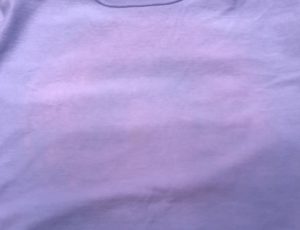If you have been screen printing for more than a few years, then you have likely encountered your share of challenges: dye migration, scorching, under curing, etc. Most of those challenges seem to have a straightforward cause and effect but there is something extra frustrating about the five-piece puzzle that is ghosting.
Let’s define what ghosting is along with an overview of the five variables that allow it to happen and then review ways to prevent it from happening again. After that, you can officially apply to be a member of the Screen Printer Ghostbuster’s team.
What is Ghosting?
Ghosting is when you have dyes in a garment stripped out because they come in contact with the screen printed image. There is a lot involved in this process, so let’s examine all five variables that must be in play.
 Variable 1: The Garment
Variable 1: The Garment
Ghosting can occur with 100% cotton, blends and even 100% polyester styles. The factors here relate to a color spectrum. Those most often challenged are mid-tone shades such as silver, Vegas gold, Carolina blue, etc. They are colors without deep color saturation or they are very light, such as white or natural tones. Components in the dye stuffs used in these shades allow for an adverse chemical reaction to take place.
 Variable 2: The Ink
Variable 2: The Ink
Chemicals found in inks that are designed to help prevent dye migration are the culprit here. Our advice is not to use these types of inks when printing on lighter colored garments. This can be difficult with a mixture of colors, so if it is necessary be extra mindful of the remaining three variables. You can also check with your ink supplier for specific non-ghosting inks.
 Variable 3: Heat
Variable 3: Heat
We all know that certain temperature thresholds must be met for ink to fully cure. It can be a delicate balancing act, but it’s a necessary one if you want to avoid heat-related damage. While initial heat can kickstart the chemicals in the ink to activate, if the garments are cooled quickly and you avoid contact with the garment, you will likely be okay.
Variable 4: Humidity
Consider this to be the hand-holding cousin to heat when it comes to ghosting. You can have all the other variables in play and things may be fine, but high humidity will change that. The moisture in the air and in the garment plays a part in the chemical reaction and so this challenge seldom occurs in dry climates or climate-controlled print shops.
Variable 5: Contact
If all four other variables are in play but you were to slip a sheet of paper between the printed image and the other part of the garment, the ghosting would never emerge. Since this is not very practical, staying vigilant and mindful of the other variables is even more important.
Prevention
- Know about the culprit colors spectrum. If you aren’t sure, double-check by contacting our team at decoratorrelations@sanmar.com.
- Use cotton inks on cotton jobs and source non-ghosting inks when the need for dye blocking comes up.
- Do not let hot garments fall into the bin or be quickly stacked. This is the number one cause for ghosting.
- Allow garments to quickly cool using fan arrays at the end of the dryer and on the stack/count tables.
While ghosting is not the most common screen printing challenge, it can be difficult (and costly) when a lot of garments are affected. Mind the variables above, consult with your ink suppliers and most importantly make sure your proton packs are fully charged to take down those ghosts!
